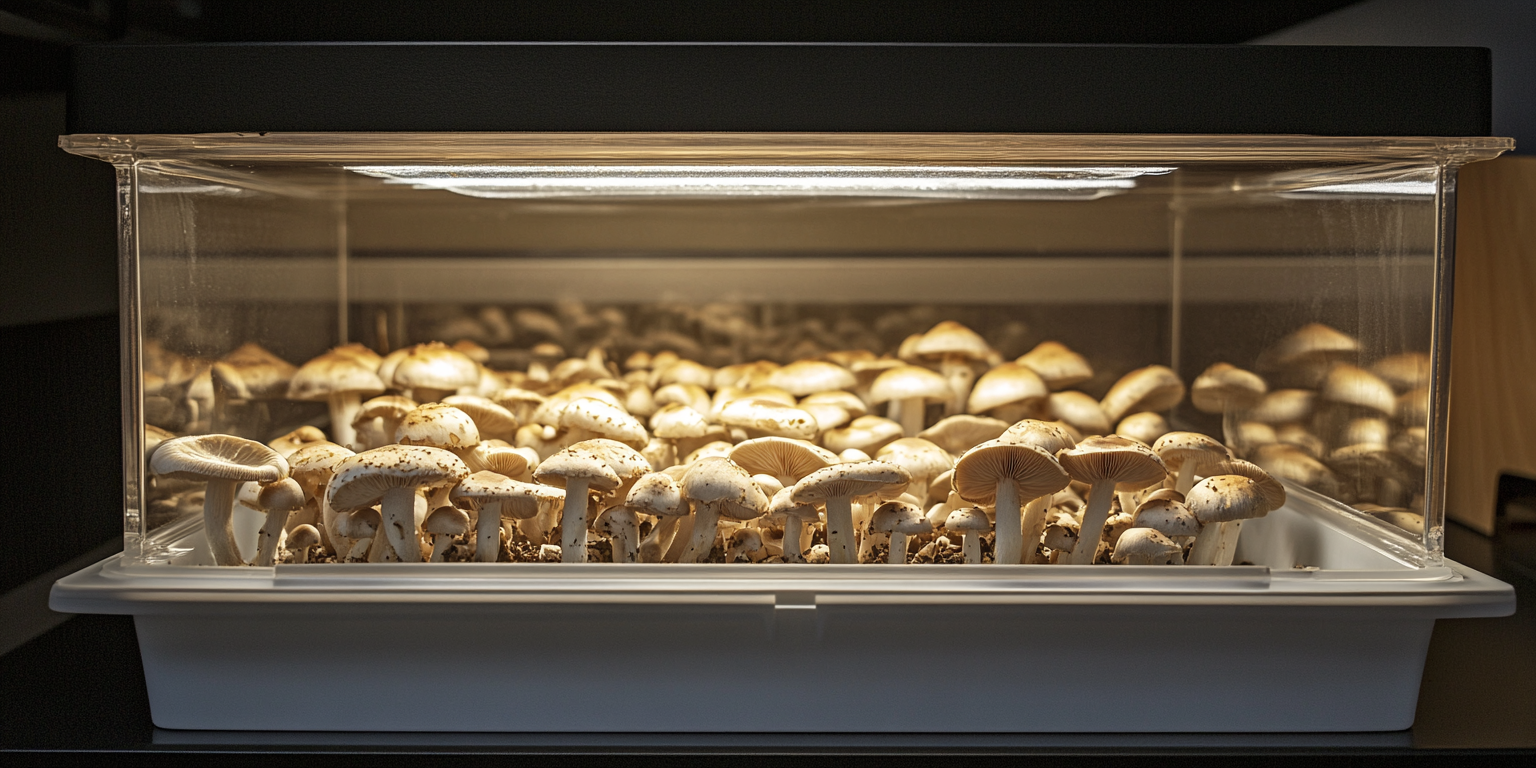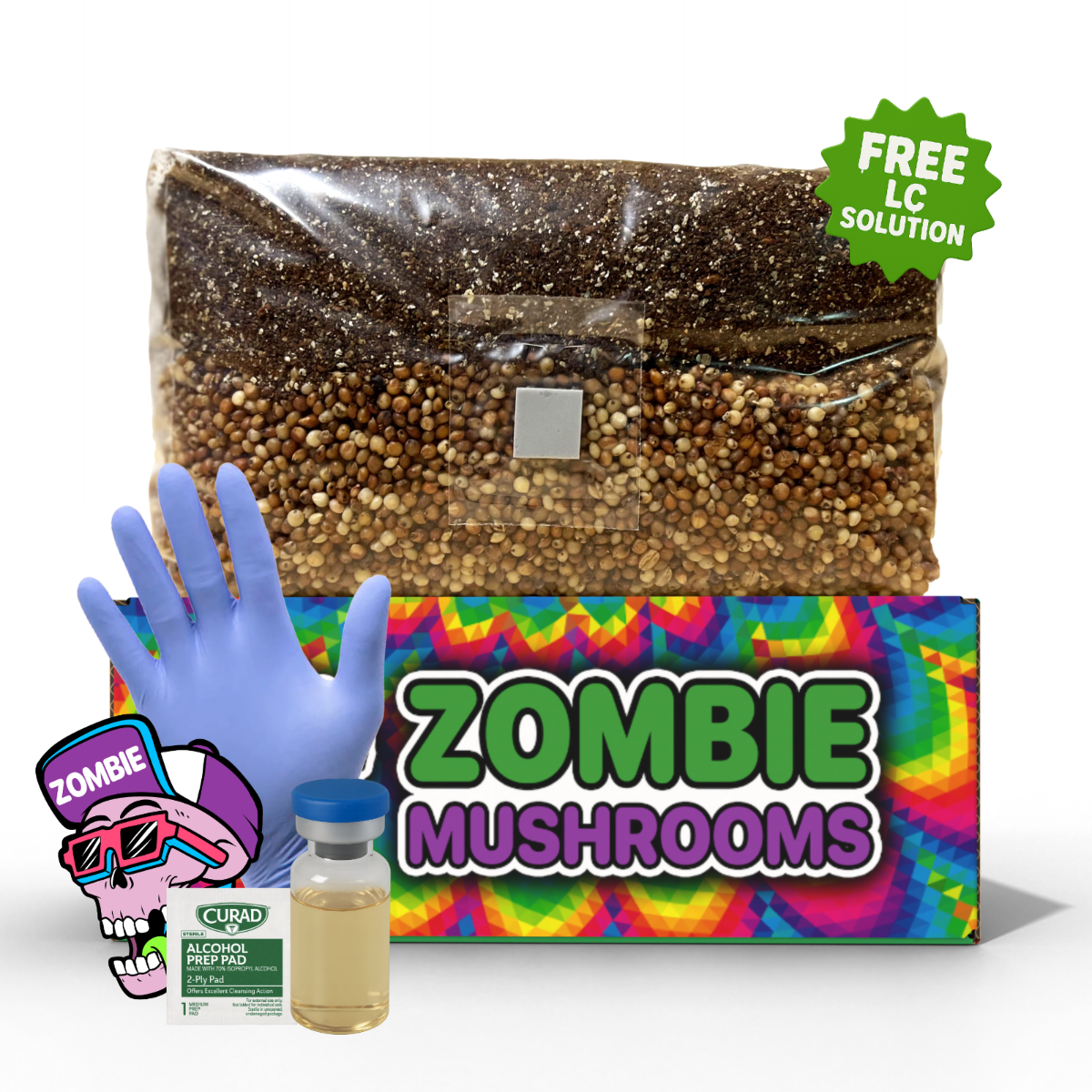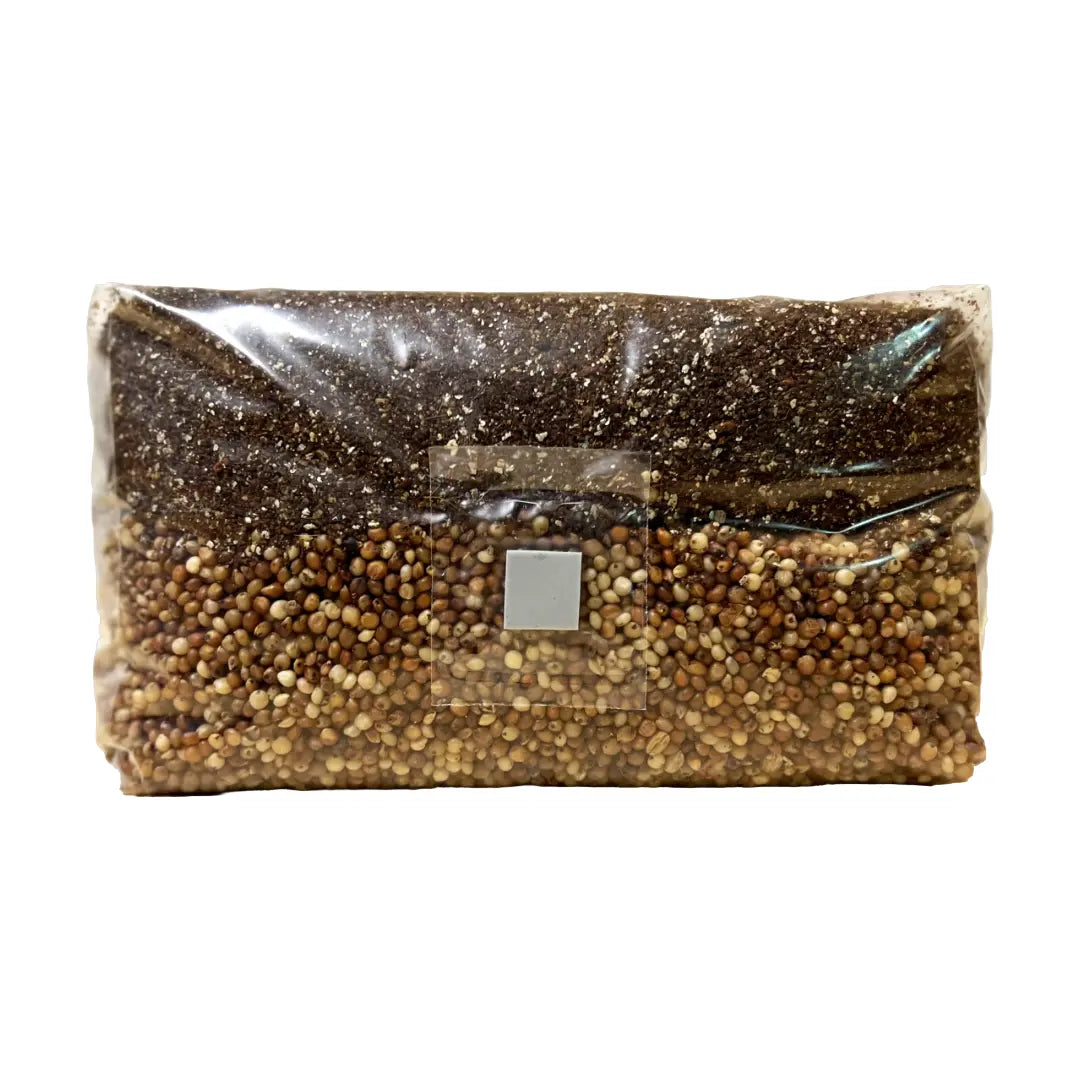Mushroom growing at home is getting more popular as more people discover the fun of growing your own edible or medicinal mushrooms. Whether you’re a mycology newbie or a gourmet looking for fresh homegrown mushrooms, there are several ways to grow mushrooms indoors. Each has its pros and cons and choosing the right one for your setup will make all the difference in your growing experience, supporting both small-scale home growing and large-scale cultivation. For beginners, our easy-to-use mushroom grow kits are the perfect way to get started, making the process simple and rewarding from the very first harvest.
Two of the most popular ways to grow mushrooms indoors are All-in-One Mushroom Grow Bags and Monotub Bins. Both have their pros and cons depending on your experience level, space, resources and personal goals. We'll explain these two mushroom growing methods in detail in this guide to help you choose.

What is an All-in-One Mushroom Grow Bag?
An All-in-One Mushroom Grow Bag is a pre-assembled kit that has most or all of the components needed to grow mushrooms in one convenient package. These grow bags come pre-filled with sterilized substrate which is a nutrient-rich material that supports mushroom growth and often spawning material like grains. The All-in-One bag simplifies the growing process by putting everything in one package so beginner growers have fewer decisions to make and less variables to control.
How does it work?
The All-in-One grow bag has a few key components:
-
Sterilized Grain: This is where you’ll inject the spores.
-
Substrate: Nutrient-rich material like coir, straw or manure-based compost that the mycelium will colonize.
-
Filter Patch: A small area for clean air to enter the bag to promote healthy mushroom growth without contaminants entering the bag.
To use the grow bag, you inject mushroom spores or liquid culture into the injection port. Once inoculated, you seal the bag and wait for the mycelium (the vegetative part of the fungus) to grow throughout the substrate. Once fully colonized, you move the bag to the fruiting stage where mushrooms will start to pop out.

What is a Monotub Mushroom Grow Chamber?
A monotub is an open-air, larger growing chamber that holds a bulk substrate and spawn mix. This method involves a plastic bin or tub that has been modified with ventilation holes covered in micropore tape or fitted with polyfill to control airflow and prevent contaminants. The Monotub method is considered more advanced because it allows for bigger yields and more control over the environment.
Monotubs are ideal for large-scale cultivation due to their capacity and control over the growing environment.
How does it work?
-
Plastic Bin: The main container for the grow. A tub is modified to allow airflow via holes which are covered with micropore tape or stuffed with polyfill.
-
Bulk Substrate: A larger portion of substrate such as a mix of coco coir, manure, straw or vermiculite that provides nutrients for the mycelium to grow through.
-
Grain Spawn: After the mycelium has colonized the top layer of substrate, the grain spawn is spread across the bulk substrate to fruit.
Once inoculated and colonized, the grower opens the monotub lid (or partially opens it depending on the stage) and enters the fruiting phase. This open-air approach allows fresh oxygen in and CO2 out while maintaining humidity and temperature. Frequent misting and fanning ensures the mushrooms get the right amount of moisture and air exchange.

Quick Comparison Breakdown: All-in-One Bags vs. Monotubs
|
Feature |
All-in-One Bags |
Monotub Bins |
|---|---|---|
|
Ease of Use |
User-friendly with low maintenance design. All materials are pre-mixed and sterilized. |
Requires more attention, especially to monitor and maintain optimal growing conditions. |
|
Setup Time |
Instant setup. Just inject the spores and you're good to go with no extra steps. |
Some initial setup required. Prepare substrate, inoculate grain spawn, and modify tub for ventilation. |
|
Maintenance |
Very little maintenance required. Ensure stable environment with basic conditions like light, humidity, and temperature. |
Requires regular maintenance like misting to maintain humidity, fanning to exchange air, and monitoring for contaminants. |
|
Yield Potential |
Smaller yields, good for personal use and homegrown projects. |
Designed for large-scale cultivation, resulting in higher yields due to substrate volume and environmental control. |
|
Cost |
Affordable for beginners, minimal upfront investment. Single-use grow bags are cost-effective for trials. |
Higher upfront cost for materials, but more cost-effective over multiple cycles. Reusable tubs and bulk substrate purchases reduce long-term costs. |
|
Skill Level |
Perfect for newbies who want a simple and easy method. |
Suitable for growers with some experience in mushroom cultivation, offering more control and bigger yields. |

Species that can be grown in All-in-One Bags vs. Monotubs
When it comes to the species you can grow, both methods can grow a wide range of species, but there’s a difference in environmental requirements:
|
Mushroom Species |
All-in-One Bags Suitability |
Monotubs Suitability |
|---|---|---|
|
Ideal for all-in-one bags as they are hardy and can thrive without precise control over fruiting conditions. |
Also suitable for monotubs, especially for larger yields and more flushes. |
|
|
Grows well in all-in-one bags, benefiting from the simple setup and minimal environmental adjustments. |
Can be grown in monotubs for more controlled conditions and potentially larger fruiting bodies. |
|
|
Work well in all-in-one bags, there may be a need to increase air exchange late in fruiting stage. Good humidity control. |
Best suited for monotubs where precise environmental conditions can be maintained for optimal growth. |
|
|
Challenging to grow in all-in-one bags due to their specific environmental needs. |
Thrives in monotubs with the ability to control humidity and temperature, allowing for successful cultivation. |
|
|
Not ideal for all-in-one bags as they require very specific growing conditions. |
Suitable for monotubs, which provide the controlled environment necessary for this species to thrive. |

Substrate for Each Method
The substrate is an important factor in mushroom growth and is slightly different for each method:
|
Method |
Substrate Details |
|---|---|
|
All-in-One Bags |
The substrate is pre-mixed, often including grains like rye or millet combined with compost or hardwood sawdust. These grow bags come with ready-made substrates tailored for each mushroom species. |
|
Monotubs |
Offers more substrate options such as coconut coir, straw, manure, or vermiculite. Growers have control over pasteurizing and mixing elements to suit various mushroom varieties. |

Space Required
|
Method |
Space Requirement |
|---|---|
|
All-in-One Bags |
These are very compact and can fit in small spaces indoors—not much bigger than a shoebox or small container. |
|
You’ll need more space to set up a monotub. Depending on the size, they may take up several square feet of space, so better for growers with garages, basements or extra room. |

Cost
The cost of mushroom growing methods varies significantly between All-in-One Grow Bags and Monotubs, catering to different needs and budgets. All-in-One Grow Bags are particularly appealing to casual hobbyists due to their affordability.
These grow kits, which come pre-sterilized and pre-prepared, can be purchased for under $50, depending on the size of the bag and the mushroom species you choose to cultivate. This makes them an excellent choice for beginners or those looking to experiment with mushroom growing without a significant financial commitment.
On the other hand, monotubs require a more substantial upfront investment. This includes purchasing or assembling various components such as the tub, substrate, ventilation materials, and systems for fan and misting.
However, once you've set up a monotub, it becomes a cost-effective option in the long run. The initial investment pays off as monotubs offer higher yields, making them ideal for those seeking a more substantial harvest over time.

Time
When considering the time investment required for each method, all-in-one bags stand out for their simplicity and speed. These bags are designed to produce results quickly, as they require no additional steps after inoculation. This streamlined process is perfect for those who prefer a straightforward approach to mushroom growing, allowing for faster enjoyment of the fruits of your labor.
Conversely, setting up a monotub demands more time, care, and attention. The process involves preparing the substrate, inoculating grain spawn, and ensuring optimal conditions for growth. While this method requires more effort initially, the rewards are substantial. The larger yields and the ability to cultivate multiple flushes make the extra time investment worthwhile for dedicated growers.

Yield
Yield potential is a critical factor when choosing between these two methods. All-in-One Bags typically yield less due to their smaller substrate volume. While a single flush can provide enough mushrooms for personal use, subsequent flushes may produce diminishing returns. This makes all-in-one bags well-suited for hobbyists or those with modest mushroom needs.
In contrast, the Monotub method is designed for those seeking larger quantities of mushrooms. The ample space and larger substrate capacity of monotubs allow for substantial yields, making them ideal for growers who wish to harvest significant amounts over several flushes. This method is particularly advantageous for those interested in large-scale cultivation or commercial mushroom production, where maximizing yield is a priority.

So, which one is for you?
When choosing between All-in-One Grow Bags and Monotub Bins, consider your goals, experience and willingness to invest time and resources.
-
If you’re new to mushroom growing, have limited space or want a low maintenance method that will give you some early success, all-in-one mushroom grow bags are for you. They’re cheap, easy to use and will give you good first-time results.
-
If you want to level up your growing skills and scale your mushroom operation or grow multiple species, a Monotub Bin setup will give you the control and scalability you need. Although it takes more time, attention and monitoring, it rewards growers with bigger and more consistent harvests.

Get Started?
Whatever method suits your growing goals, you’re already on your way to mushroom-growing fun! Our shop has resources for beginners and intermediate growers, all-in-one mushroom grow bags, and monotub kits. Check out our spores, grow kits and substrates to start your mushroom growing today!
Key Takeaways:
-
Ease of Use: All-in-One bags are more user-friendly, especially for beginners. Monotubs offer more control but require more experience.
-
Space: All-in-One bags for tight spaces, monotubs for larger areas.
-
Yield: Monotubs yield much more than All-in-One bags, perfect for commercial or large-scale production.
-
Monotubs are ideal for large-scale cultivation due to their ability to produce larger yields.
-
-
Cost: Both methods have different costs; all-in-one bags are cheaper upfront and monotubs are more cost-effective long-term after multiple uses.
-
Maintenance: All-in-One bags require little maintenance; monotubs require regular maintenance to ensure optimal growing conditions.
-
Species: Both methods can grow multiple species. Monotubs can grow more species, including more demanding ones like Psilocybe cubensis.
Whatever method you choose, mushroom growing is fun!



